MSI GF65 Thin 10Sx review – set your expectations correctly
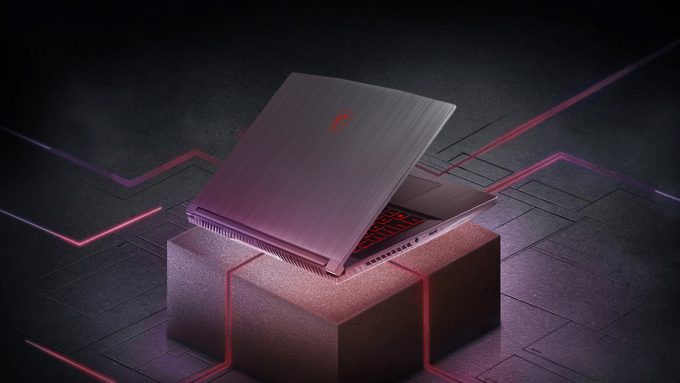 Okay, everybody, today we have the return of the dragon. Or… the thin and light dragon… or the fashion dragon. Who cares. We are talking about the MSI GF65 Thin 10Sx, that is now outfitted with the 10th Generation Intel processors, and can be purchased with an RTX GPU!
Okay, everybody, today we have the return of the dragon. Or… the thin and light dragon… or the fashion dragon. Who cares. We are talking about the MSI GF65 Thin 10Sx, that is now outfitted with the 10th Generation Intel processors, and can be purchased with an RTX GPU!
But wait a second. When we tested the GF63 last year, it was barely able to handle a GTX 1050 Ti Max-Q. How is it going to ever cool down an RTX 2060? Well, it happens that MSI has worked a lot over their new laptop and its cooling solution. And naturally, we are eager to test how good (or bad) of a job did they do!
Additionally, you have three display options, including 60Hz, 120Hz, and 144Hz units. Ultimately, we got the middle ground, and we really hope it doesn’t suck like the one on the MSI GL65 9SE. Now let’s open the box, and take a look at what you get.
You can check the prices and configurations in our Specs System: https://laptopmedia.com/series/msi-gf65-thin-10sx/
Contents
Specs Sheet
- HDD/SSD
- hasta 4000GB SSD
- Ranura M.2
- 1x 2280 M.2 NVMe slot + 1x 2280 M.2 NVMe/SATA slot Ver foto
- RAM
- up to 64GB
- OS
- Windows 11 Pro, Windows 10 Pro, Windows 11 Home, Windows 10 Home
- Batería
- 51Wh, 3-cell
- Material del cuerpo
- Plastic / Polycarbonate, Aluminum
- Dimensiones
- 359 x 254 x 21.7 mm (14.13" x 10.00" x 0.85")
- Peso
- 1.86 kg (4.1 lbs)
- Puertos y conectividad
- 2x USB Type-A
- 3.2 Gen 1 (5 Gbps)
- 2x USB Type-C
- 3.2 Gen 1 (5 Gbps)
- HDMI
- 4K@30Hz
- Ethernet LAN
- GB Lan
- Wi-Fi
- 802.11ax
- Bluetooth
- 5.1
- Conector de audio
- 3.5 mm combo
- Features
- Lector de huellas dactilares
- Cámara web
- HD (720p@30FPS)
- Teclado retroiluminado
- Micrófono
- Altavoces
- 2x 2W, Nahimic 3
- Unidad óptica
- Ranura de bloqueo de seguridad
Todo MSI GF65 Thin 10Sx configuraciones
What’s in the box?
Apart from its black color, there is nothing particularly interesting inside of the box. Only some paper manuals and a 180W power brick. Oh yes, and an MSI GF65 Thin 10Sx, of course.
Design and construction
For this year’s device, MSI is using aluminum for the lid cover and the base, and plastic for the rest. Surely, the laptop looks really sleek with its brushed simple cover and painted Red logo. Other than that, it gives a sporty vibe, and has a profile of 21.7mm, while the weight is just about 1.86 kg. Indeed, this is one of MSI’s Thinnest notebooks (see what we did there).
Surprisingly or not, the lid opens easily with a single hand. And although it is pretty susceptible to bends, that even result in color shifting in the display, we are not entirely disappointed. By the way, the side bezels look very thin, while the top and the bottom ones are pretty bulky. Also, you’re going to find an HD camera above the display.
After you open the lid, you are going to see a keyboard glowing in Red. As you can tell from the image below, it doesn’t have a NumberPad section, and most of the gamers wouldn’t mind it… we do, though. And despite the large size of the Arrow keycaps, they are crammed into the rest of the buttons, which make them harder to hit, should you look at the display only. Actually, we like using the Arrow keys, and for now, one of the most comfortable ones we’ve used was on the Legion laptops, and from this year – on the HP Omen 15 2020 (15-ek0000).
Nevertheless, there is another little setback with this keyboard. Its key travel is really short. And while the quiet feedback can be useful for libraries and offices, it is a bit frustrating during gaming sessions. On the bright side, the Power button is located away from the keyboard – in the top right corner.
So, at least the touchpad is going to be good, right? Well… no. The actual tracking and gliding are decent, but our particular unit had a huge dead zone for the mouse click. Actually, the entire touchpad moves more in a dead position, than when it actually clicks, which is pathetic. However, it might just be a problem with our model, but it can pretty much be an issue with the series as well.
Lastly, there is the bottom panel, where we see another weird decision by MSI. As you can see, the entire ventilation grill is placed nowhere near the fans. And at first, we were really puzzled, and thought, okay this is a very stupid decision. But then, we tested the laptop and *spoiler alert* there is an actual reason for that. See, when the fans work, the air is drawn to the middle of the laptop, hence cooling the tips of the heat pipes, which means less heat is dissipated downwards. And what you get from that is comfortability when the notebook is placed on your lap. However, there are other implications, that you are going to see in a minute. By the way, on the bottom panel, you can also see the speaker cutouts. And in contrast to the MSI GF63 Thin, this model exhaust air from three big vents (two on the back and one on the left side).
Ports
On the left side, you’ll see the power plug and an HDMI connector. And on the right, there is an RJ-45 connector, two USB Type-C 3.2 (Gen. 2) ports, two USB Type-A 3.2 (Gen. 2) ports, and an audio jack.
Disassembly, upgrade options and maintenance
In order to get inside of this notebook, you need to undo 12 Phillips-head screws. Afterwards, you have to pry the bottom panel with a plastic tool. You can start from the front, and work away around the device, leaving the left side for the end.
As usual, MSI likes to show off its heat pipes, so they left them in the natural copper color. Here, you can see two heat pipes cooling the CPU alone, and three dedicated to the GPU. There is an additional one for the graphics memory, while two of the GPU heat pipes are passing through the VRMs.
In terms of upgrades, you can put up to 64GB of DDR4 memory in total in dual-channel mode. Storage-wise, there are two M.2 drive slots. One of them can hold PCIe drives only, while the other can utilize both PCIe and SATA drives.
Lastly, there is a 52Wh battery pack, which is glued to the chassis. Thankfully, the glue is more like double-sided tape, and taking off the unit is not very difficult, whatsoever.
Display quality
MSI GF65 Thin 10Sx in the configuration we tested has a Full HD 120Hz IPS panel with a model number AUO B156HAN13.0 (AUOD0ED). Its diagonal is 15.6″ (39.62 cm), and the resolution 1920 х 1080 pixels. The screen ratio is 16:9, and we are looking at a pixel density of – 142 ppi, and a pitch of 0.18 х 0.18 mm. The screen turns into Retina when viewed at distance equal to or greater than 60cm (24″) (from this distance one’s eye stops differentiating the separate pixels, and it is normal for looking at a laptop).
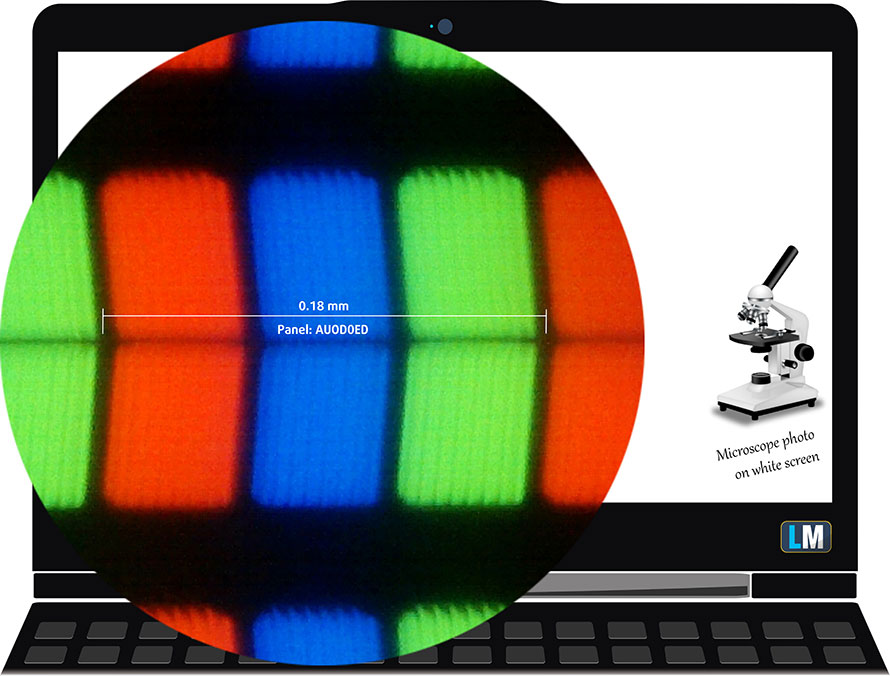
Viewing angles are excellent. We offer images at 45° to evaluate image quality.

We measured a maximum brightness of 262 nits in the middle of the screen and 235 nits as an average for the whole area, with a maximum deviation of 9%. The Correlated Color Temperature on a white screen is 6570K – virtually matching the optimal for the sRGB standard of 6500K, which is not bad at all.
In the illustration below you can see how the display performs from a uniformity perspective. In other words, the leakage of light from the light source.
Values of dE2000 over 4.0 should not occur, and this parameter is one of the first you should check if you intend to use the laptop for color-sensitive work. The contrast ratio is good – 1320:1.
To make sure we are on the same page, we would like to give you a little introduction to the sRGB color gamut and the Adobe RGB. To start, there’s the CIE 1976 Uniform Chromaticity Diagram that represents the visible specter of colors by the human eye, giving you a better perception of the color gamut coverage and the color accuracy.
Inside the black triangle, you will see the standard color gamut (sRGB) that is being used by millions of people in HDTV and on the web. As for the Adobe RGB, this is used in professional cameras, monitors, etc for printing. Basically, colors inside the black triangle are used by everyone and this is the essential part of the color quality and color accuracy of a mainstream notebook.
Still, we’ve included other color spaces like the famous DCI-P3 standard used by movie studios, as well as the digital UHD Rec.2020 standard. Rec.2020, however, is still a thing of the future and it’s difficult for today’s displays to cover that well. We’ve also included the so-called Michael Pointer gamut, or Pointer’s gamut, which represents the colors that naturally occur around us every day.
The yellow dotted line shows MSI GF65 Thin 10Sx’s color gamut coverage.
Its display covers only 50% of the sRGB/ITU-R BT.709 (web/HDTV standard) in CIE1976.
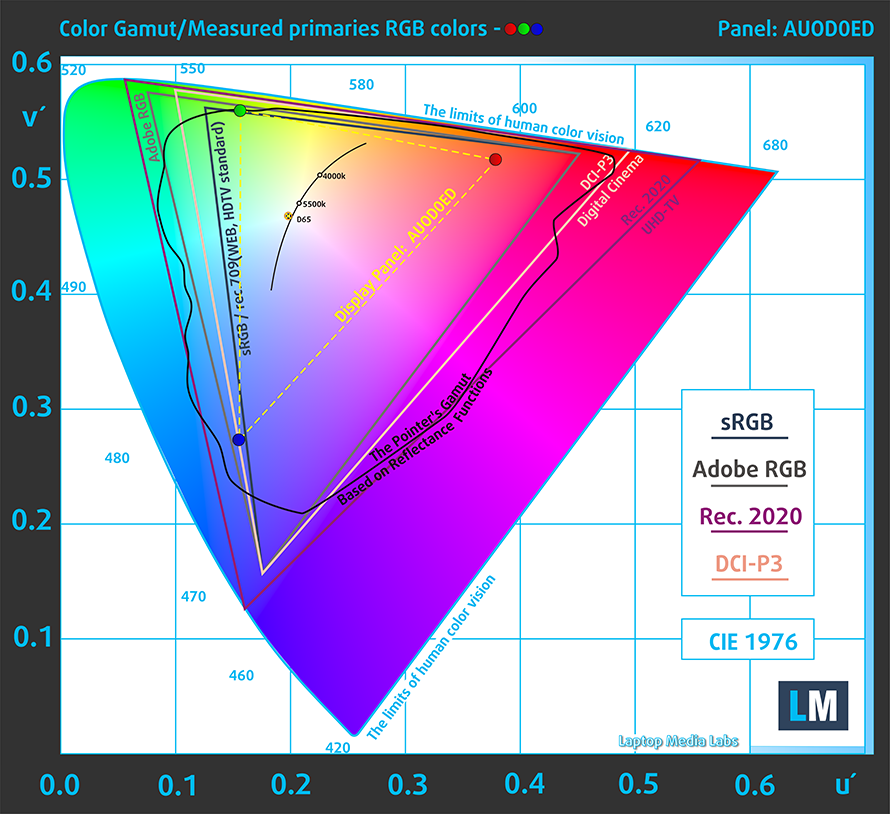
Our “Design and Gaming” profile delivers optimal color temperature (6500K) at 140 cd/m2 luminance and sRGB gamma mode.
We tested the accuracy of the display with 24 commonly used colors like light and dark human skin, blue sky, green grass, orange, etc. You can check out the results at factory condition and also, with the “Design and Gaming” profile.
Below you can compare the scores of MSI GF65 Thin 10Sx with the default settings (left), and with the “Gaming and Web design” profile (right).
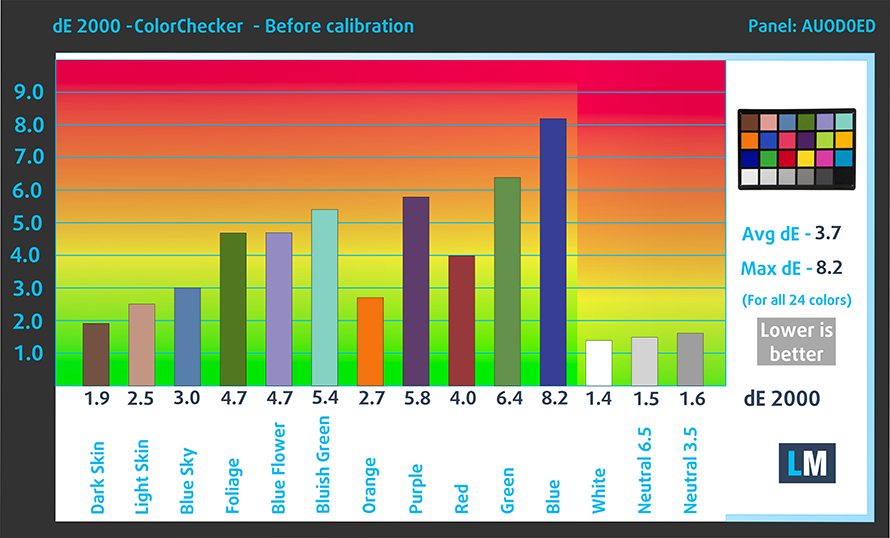
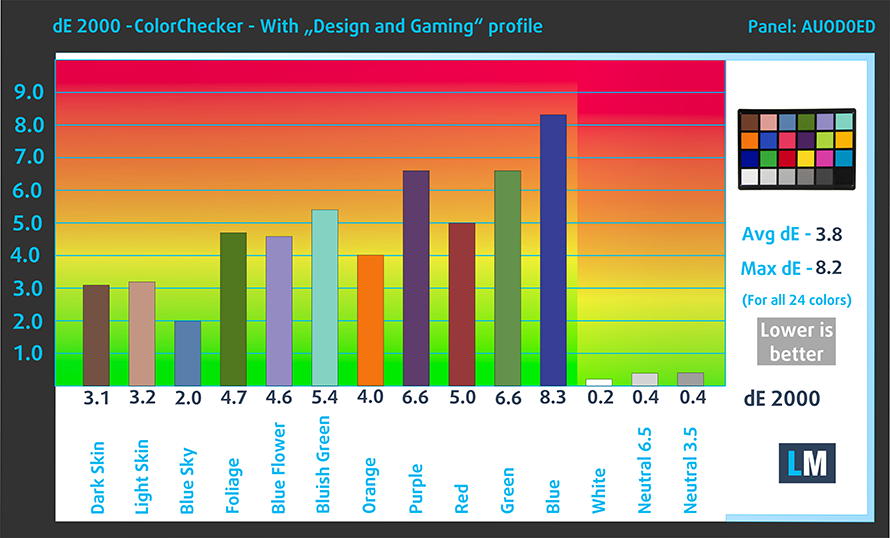
The next figure shows how well the display is able to reproduce really dark parts of an image, which is essential when watching movies or playing games in low ambient light.
The left side of the image represents the display with stock settings, while the right one is with the “Gaming and Web Design” profile activated. On the horizontal axis, you will find the grayscale and on the vertical axis – the luminance of the display. On the two graphs below you can easily check for yourself how your display handles the darkest nuances but keep in mind that this also depends on the settings of your current display, the calibration, the viewing angle, and the surrounding light conditions.

Response time (Gaming capabilities)
We test the reaction time of the pixels with the usual “black-to-white” and “white-to-black” method from 10%to 90% and vice versa.
We recorded Fall Time + Rise Time = 23 ms
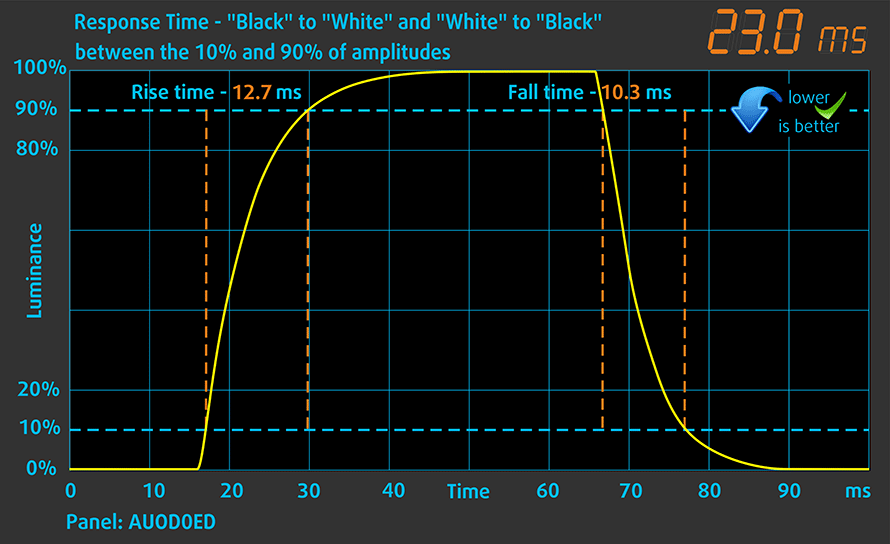
PWM (Screen flickering)
Pulse-width modulation (PWM) is an easy way to control monitor brightness. When you lower the brightness, the light intensity of the backlight is not lowered, but instead turned off and on by the electronics with a frequency indistinguishable to the human eye. In these light impulses, the light/no-light time ratio varies, while brightness remains unchanged, which is harmful to your eyes. You can read more about that in our dedicated article on PWM.
MSI GF65 Thin 10Sx’s display doesn’t flicker at any brightness level. This provides comfort in extended periods of use.

Blue light emissions
Installing our Health-Guard profile not only eliminates PWM but also reduces the harmful Blue Light emissions while keeping the colors of the screen perceptually accurate. If you’re not familiar with the Blue light, the TL;DR version is – emissions that negatively affect your eyes, skin, and your whole body. You can find more information about that in our dedicated article on Blue Light.
Conclusion
The MSI GF65 Thin 10Sx is equipped with the same 120Hz IPS panel as the GL65 9SE. It has a Full HD resolution, comfortable viewing angles, and a good contrast ratio. Additionally, it doesn’t use PWM for brightness adjustment. Unfortunately, however, it is able to display only half of the colors found on the Internet and its quick refresh rate is paired with really slow response times, resulting in ghosting in fast-paced games.
Buy our profiles
Since our profiles are tailored for each individual display model, this article and its respective profile package are meant for MSI GF65 Thin 10Sx configurations with 15.6″ FHD IPS AUO B156HAN13.0 (AUOD0ED).
*Should you have problems with downloading the purchased file, try using a different browser to open the link you’ll receive via e-mail. If the download target is a .php file instead of an archive, change the file extension to .zip or contact us at [email protected].
Read more about the profiles HERE.
Además de recibir perfiles eficientes y respetuosos con la salud, al comprar los productos de LaptopMedia también apoyas el desarrollo de nuestros laboratorios, donde probamos los dispositivos para elaborar las reseñas más objetivas posibles.

Trabajo de oficina
El perfil Trabajo de Oficina debería ser utilizado sobre todo por usuarios que pasan la mayor parte del tiempo mirando trozos de texto, tablas o simplemente navegando. Este perfil pretende ofrecer una mayor nitidez y claridad manteniendo una curva de gamma plana (2,20), una temperatura de color nativa y colores perceptualmente precisos.

Diseño y juego
Este perfil está dirigido a los diseñadores que trabajan con los colores de forma profesional, y también para juegos y películas. Design and Gaming lleva a los paneles de visualización a sus límites, haciéndolos tan precisos como sea posible en el estándar sRGB IEC61966-2-1 para Web y HDTV, en el punto blanco D65.

Salud-Guardia
Salud-Guardia elimina la perjudicial Modulación de Ancho de Pulso (PWM) y reduce la luz azul negativa que afecta a nuestros ojos y a nuestro cuerpo. Al estar adaptado a cada panel, consigue mantener los colores perceptivamente precisos. Salud-Guardia simula el papel, por lo que la presión sobre los ojos se reduce considerablemente.
Consigue los 3 perfiles con un 33% de descuento
Sound
MSI GF65 Thin 10Sx’s speakers produce a sound with not very loud maximum volume. On the bright side, the low, mid, and high tones are clear of deviations.
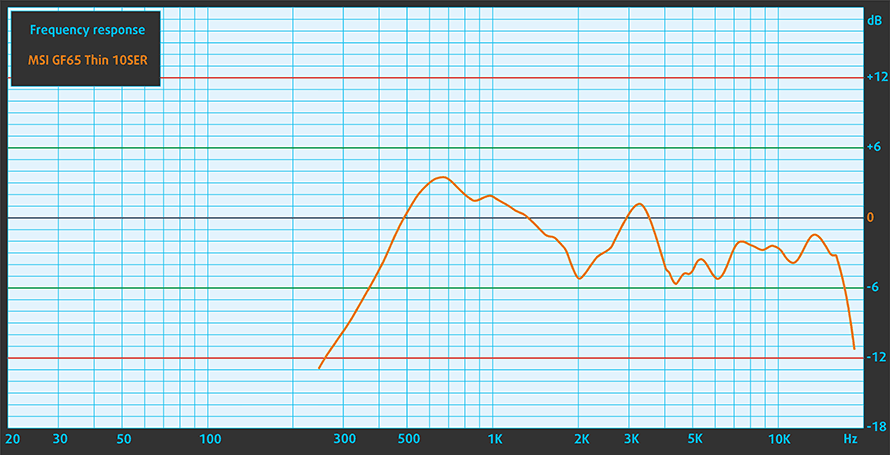
Drivers
All of the drivers and utilities for this notebook can be found here: https://www.msi.com/Laptop/support/GF65-Thin-10SX
Battery
Now, we conduct the battery tests with Windows Better performance setting turned on, screen brightness adjusted to 120 nits, and all other programs turned off except for the one we are testing the notebook with. Since we had a problem with our sample, we weren’t able to perform any battery tests.
CPU options
Currently, we can find this laptop with the Core i7-10750H. Additionally, it might be available with Core i5-10300H, as well.
GPU options
In terms of graphics, there are two pretty powerful GPUs you can choose from – the GTX 1660 Ti and the RTX 2060.
Gaming tests

| Far Cry 5 | Full HD, Normal (Check settings) | Full HD, High (Check settings) | Full HD, Ultra (Check settings) |
|---|---|---|---|
| NVIDIA GeForce RTX 2060 | 102 fps | 94 fps | 89 fps |

| Rise of the Tomb Raider (2016) | Full HD, Medium (Check settings) | Full HD, Very High (Check settings) | Full HD, MAX (Check settings) |
|---|---|---|---|
| NVIDIA GeForce RTX 2060 | 126 fps | 65 fps | 43 fps |

| Tom Clancy’s Ghost Recon Wildlands | Full HD, High (Check settings) | Full HD, Very High (Check settings) | Full HD, Ultra (Check settings) |
|---|---|---|---|
| NVIDIA GeForce RTX 2060 | 82 fps | 72 fps | 47 fps |

| Shadow of the Tomb Raider (2018) | Full HD, Medium (Check settings) | Full HD, High (Check settings) | Full HD, Highest (Check settings) |
|---|---|---|---|
| NVIDIA GeForce RTX 2060 | 84 fps | 78 fps | 50 fps |
Temperatures and comfort
Max CPU load
In this test we use 100% on the CPU cores, monitoring their frequencies and chip temperature. The first column shows a computer’s reaction to a short load (2-10 seconds), the second column simulates a serious task (between 15 and 30 seconds), and the third column is a good indicator of how good the laptop is for long loads such as video rendering.
Average core frequency (base frequency + X); CPU temp.
| Intel Core i7-10750H (45W TDP) | 0:02 – 0:10 sec | 0:15 – 0:30 sec | 10:00 – 15:00 min |
|---|---|---|---|
| MSI GF65 Thin 10Sx | 3.59 GHz (B+38%) @ 95°C | 3.48 GHz (B+34%) @ 95°C | 3.08 GHz (B+18%) @ 91°C |
| HP Pavilion Gaming 16 (16-a0000) | 3.74 GHz (B+44%) @ 97°C | 3.17 GHz (B+22%) @ 88°C | 2.98 GHz (B+15%) @ 78°C |
| HP Omen 15 2020 (15-ek0000) | 3.55 GHz (B+37%) @ 71°C | 2.88 GHz (B+11%) @ 62°C | 2.81 GHz (B+8%) @ 70°C |
| Acer Predator Helios 300 (PH315-53) | 3.56 GHz (B+37%) @ 76°C | 3.52 GHz (B+35%) @ 85°C | 2.98 GHz (B+15%) @ 75°C |
| Dell G5 15 5500 | 3.82 GHz (B+47%) @ 75°C | 3.63 GHz (B+40%) @ 99°C | 3.01 GHz (B+16%) @ 81°C |
| ASUS ROG Strix G15 G512 | 4.16 GHz (B+60%) @ 81°C | 3.99 GHz (B+53%) @ 95°C | 3.52 GHz (B+35%) @ 87°C |
| Acer Nitro 5 (AN517-52) | 3.05 GHz (B+17%) @ 68°C | 3.05 GHz (B+17%) @ 75°C | 2.90 GHz (B+12%) @ 79°C |
| Acer Nitro 5 (AN515-55) | 3.02 GHz (B+16%) @ 82°C | 3.04 GHz (B+17%) @ 92°C | 2.67 GHz (B+3%) @ 92°C |
| Lenovo Legion 7 (15) | 3.78 GHz (B+45%) @ 80°C | 3.69 GHz (B+42%) @ 83°C | 3.51 GHz (B+35%) @ 83°C |
It is clear that MSI is pushing the cooling solution to its limitts. The Core i7-10750H here is always working at a frequency higher than 3.00 GHz during extreme workloads. However, the temperature is also always exceeding 90C.
Real-life gaming
| NVIDIA GeForce RTX 2060 | GPU frequency/ Core temp (after 2 min) | GPU frequency/ Core temp (after 30 min) | GPU frequency/ Core temp (after 30 min + fan boost) |
|---|---|---|---|
| MSI GF65 Thin 10Sx | 1434 MHz @ 84°C | 1421 MHz @ 86°C | – |
| Acer Predator Helios 300 (PH315-53) | 1506 MHz @ 77°C | 1457 MHz @ 82°C | 1671 MHz @ 76°C |
| MSI GL65 9SE | 1590 MHz @ 71°C | 1588 MHz @ 73°C | 1590 MHz @ 68°C |
| ASUS ROG Zephyrus M GU502 | 1454 MHz @ 76°C | 1394 MHz @ 85°C | – |
| MSI GS65 Stealth 8SE | 1305 MHz @ 77°C | 1267 MHz @ 80°C | – |
| Dell G5 15 5590 | 1400 MHz @ 72°C | 1438 MHz @ 70°C | – |
| Lenovo Legion Y740 | 1526 MHz @ 70°C | 1499 MHz @ 74°C | – |
And sadly, when we look at the temperatures during gameplay, things don’t look any better. In fact, the GF65 Thin 10Sx is one of the worst laptops we’ve ever tested with the RTX 2060 when it comes to the cooling setup. It’s also worth saying that the GPU is running at 80W TGP.
Gaming comfort
Do you remember what we told you a couple of sections ago, that the bottom plate of the laptop remains cool even after a long gaming session? Well, we can’t say the same about the base. Actually, the top part of the keyboard is warmer than 55C and the area above the keyboard is too hot to the touch. Literally. Additionally, the laptop is way too loud.
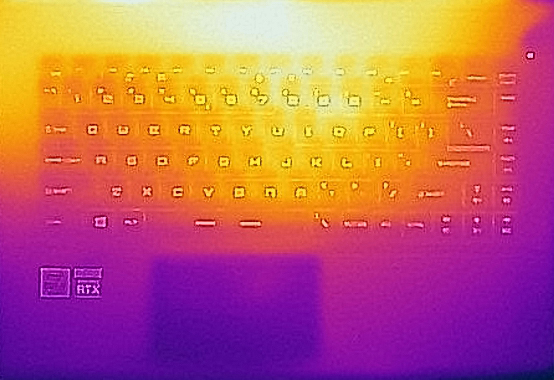

Verdict
After everything we said, there are a couple of things you don’t know. The notebook comes with Wi-Fi 6 onboard. However, you should know that the MSI GF65 Thin 10Sx is actually not a bad gaming laptop. It runs all of the latest AAA titles, and with good fps. It also supports up to 64GB of DDR4 memory in dual-channel and has two M.2 slots – one for PCIe drives and one for both PCIe and SATA devices – not too shabby.
However, playing games on the laptop itself can be kind of frustrating. First of all, there are the input devices. While the keyboard has a short key travel and somewhat mushy feedback, the trackpad is simply terrible. We said it once, we’re going to say it again – it might be an issue with our particular unit, but the touchpad had such a big dead zone before it clicks, that it just wobbles in one place unless you push it hard.
Also, cooling is a big “no-no”. While MSI utilizes five heat pipes, the fans just suffocate due to the lack of direct air ventilation, and this results in a very loud noise coming from them and naturally – high temperatures. Both the CPU and the GPU are running into the high 80s after no more than 5 minutes of gaming. Actually, we think that some of this can be dealt with by undervolting the GPU, but still, the poor design is poor design, no matter how hard you want to fix it. By the way, there is a slight advantage of the method of putting vents over the middle part of the notebook. And that is, that the air rushing through them is going to cool the bottom panel, itself, which results in a somewhat comfortable usage when playing with the laptop in your lap.
On the other side, the keyboard gets so warmed up, that you can quickly forget about the rest. Also, we have to mention that our sample had an issue with its battery, and we weren’t able to run our battery life tests. However, we are working on getting another unit, so we can complete our run of tests.
The MSI GF65 Thin 10Sx is equipped with the same 120Hz IPS panel (AUO B156HAN13.0) as the GL65 9SE. It has a Full HD resolution, comfortable viewing angles, and a good contrast ratio. Additionally, it doesn’t use PWM for brightness adjustment. Unfortunately, however, it is able to display only half of the colors found on the Internet and its quick refresh rate is paired with really slow response times, resulting in ghosting in fast-paced games.
So, if you get an external monitor, mouse, and keyboard, then undervolt your graphics card and make sure you use a cooling pad, this would be the perfect laptop for you.
Pros
- Thin and light chassis
- Two M.2 NVMe slots and up to 64GB of dual-channel memory
- Lack of PWM-adjusted brightness (AUO B156HAN13.0)
- Good price
Cons
- Lacks an SD card slot and Thunderbolt 3 support
- Uncomfortable input devices
- Underdesigned cooling solution
- Covers only 50% of sRGB (AUO B156HAN13.0)
- Slow pixel response times, despite the 120Hz refresh rate (AUO B156HAN13.0)
You can check the prices and configurations in our Specs System: https://laptopmedia.com/series/msi-gf65-thin-10sx/

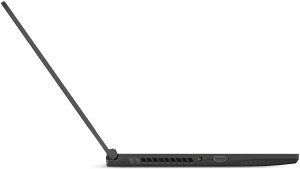

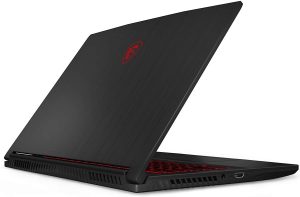
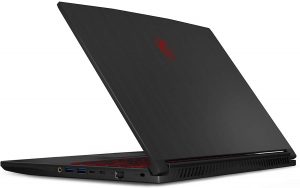
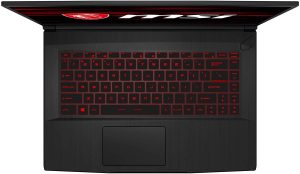
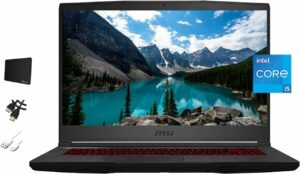

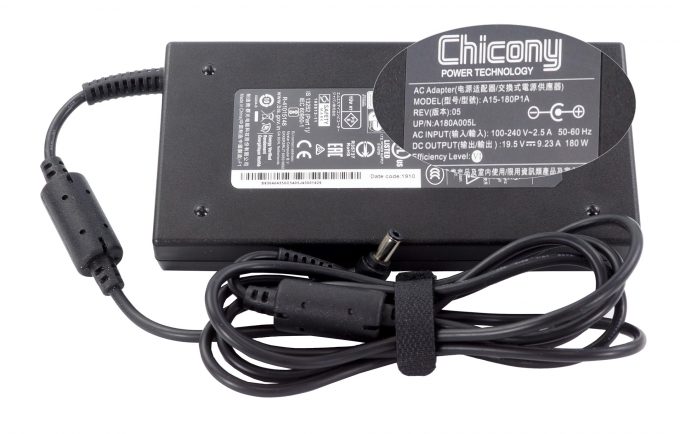
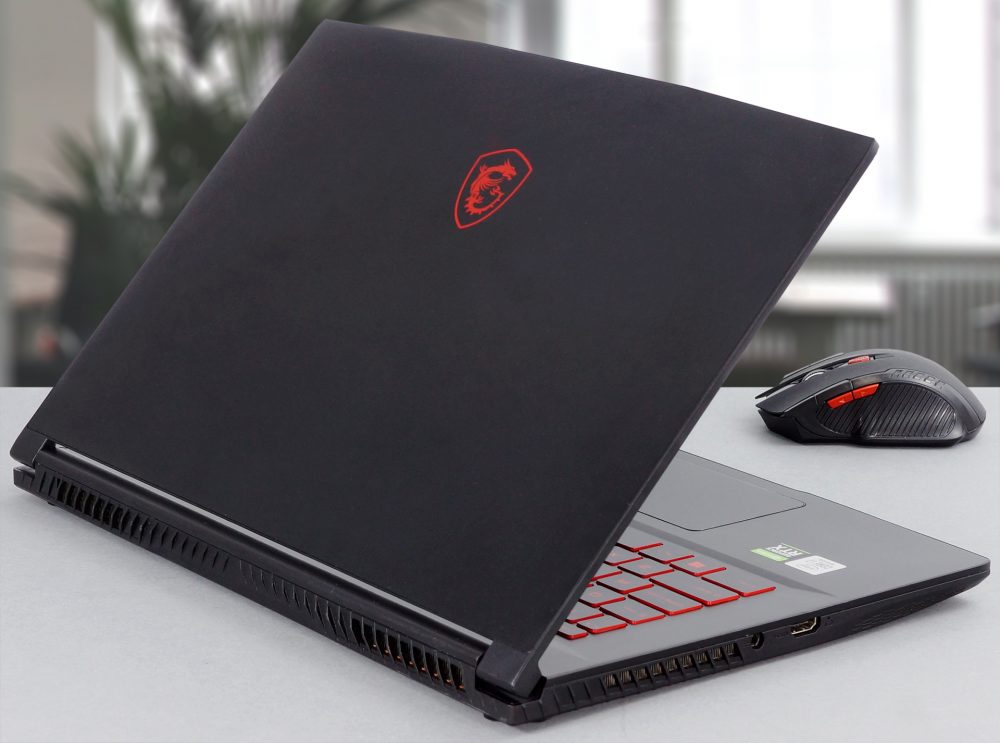
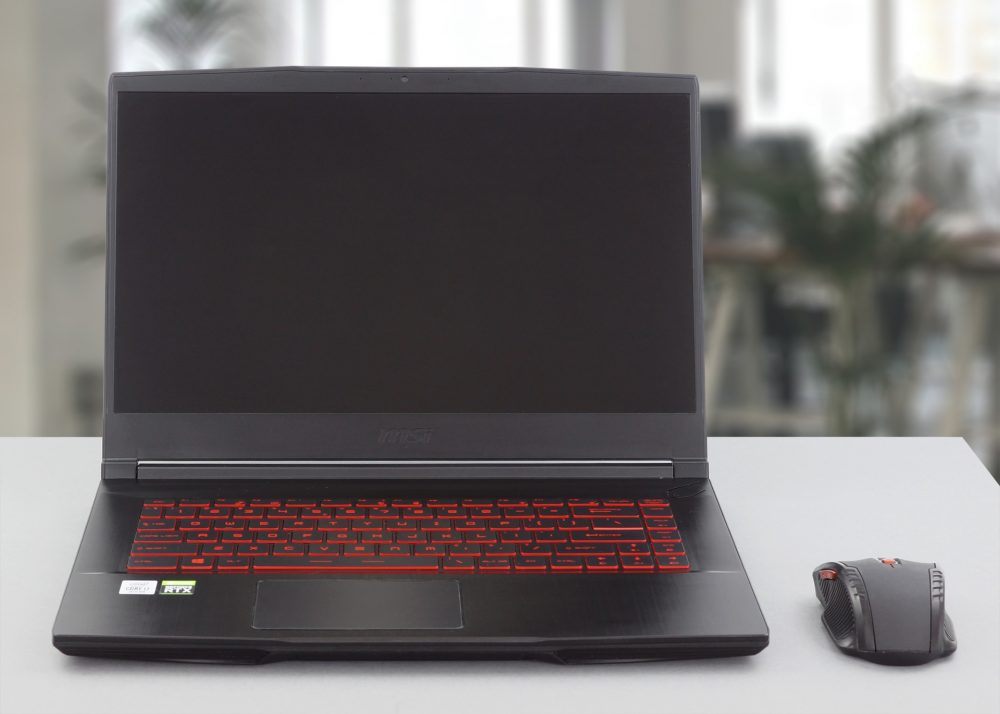
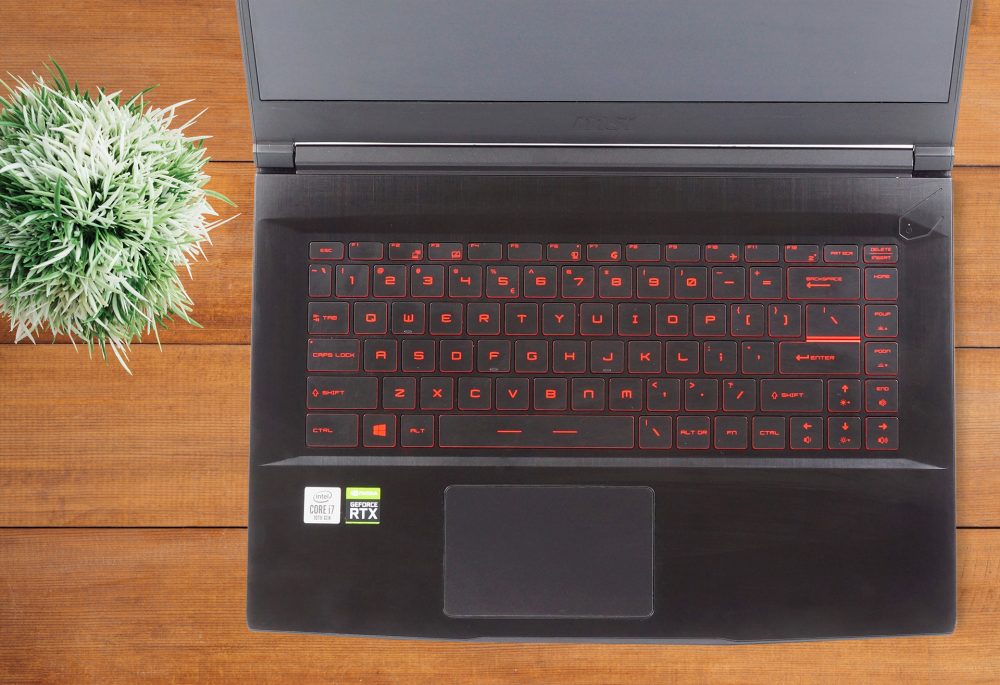
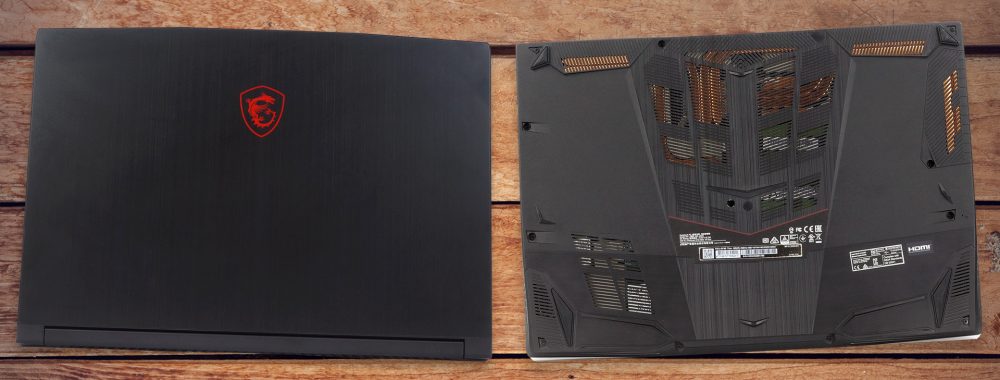


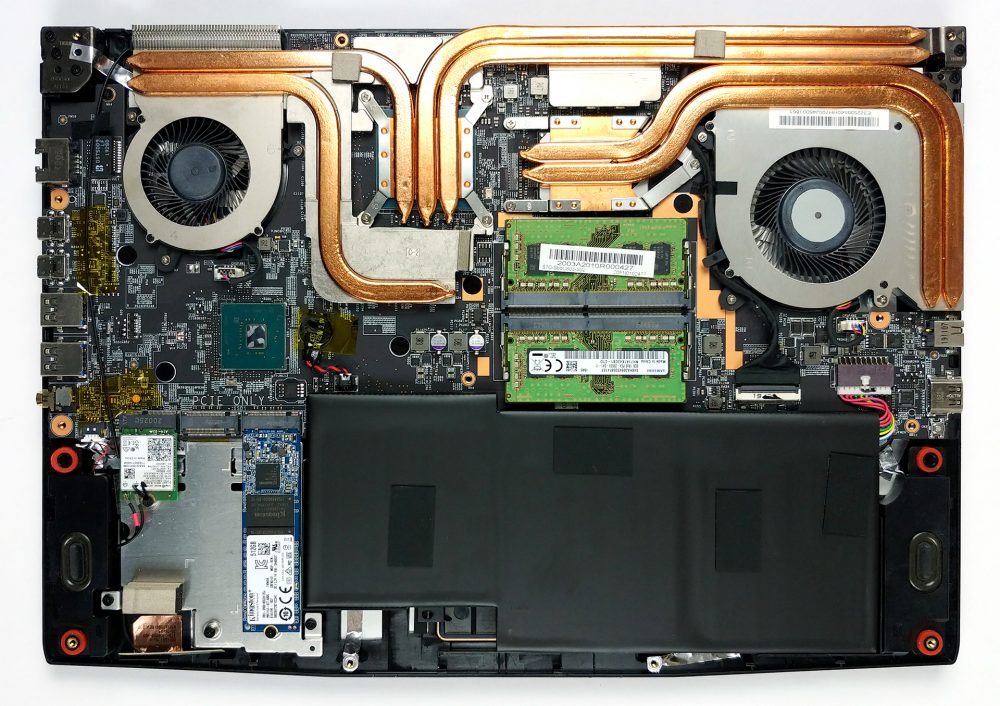
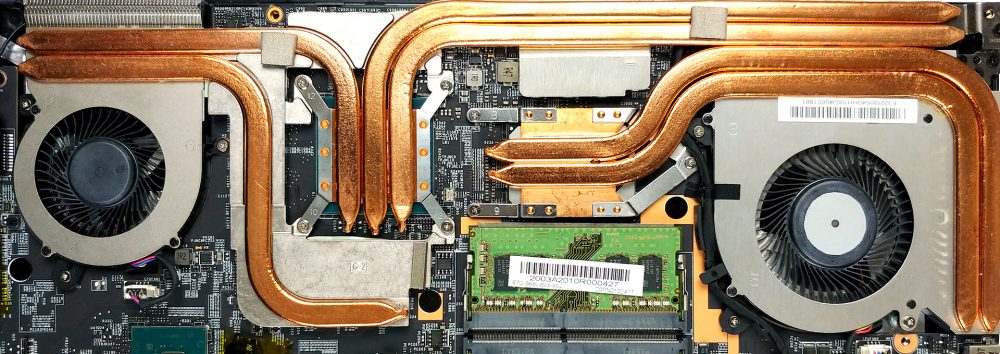
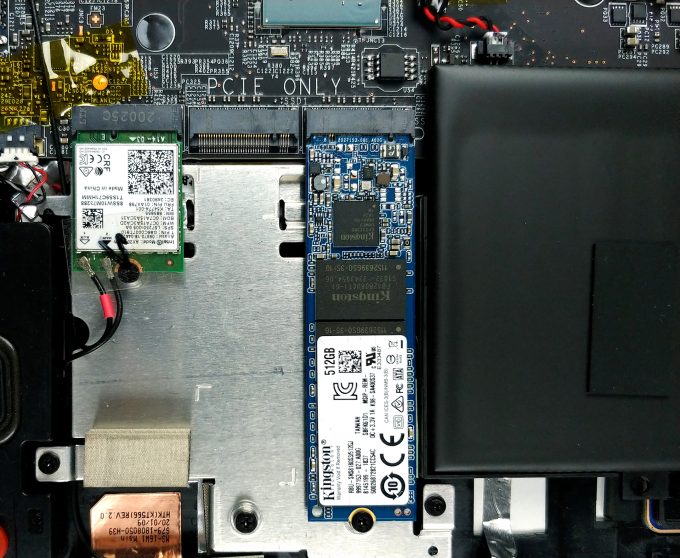
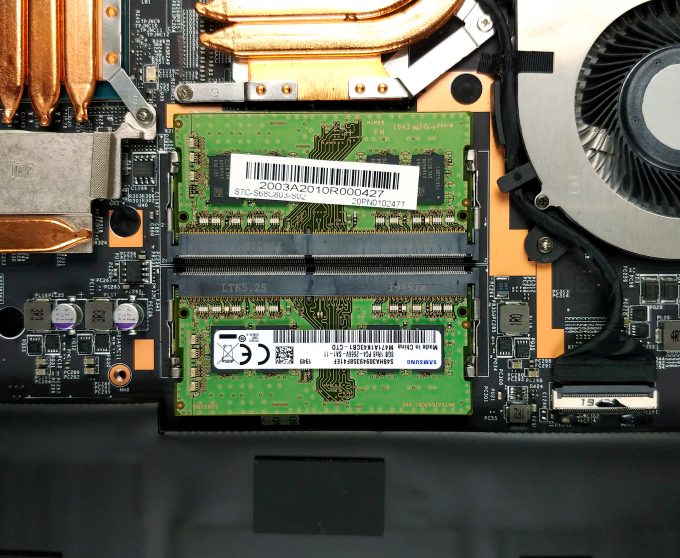
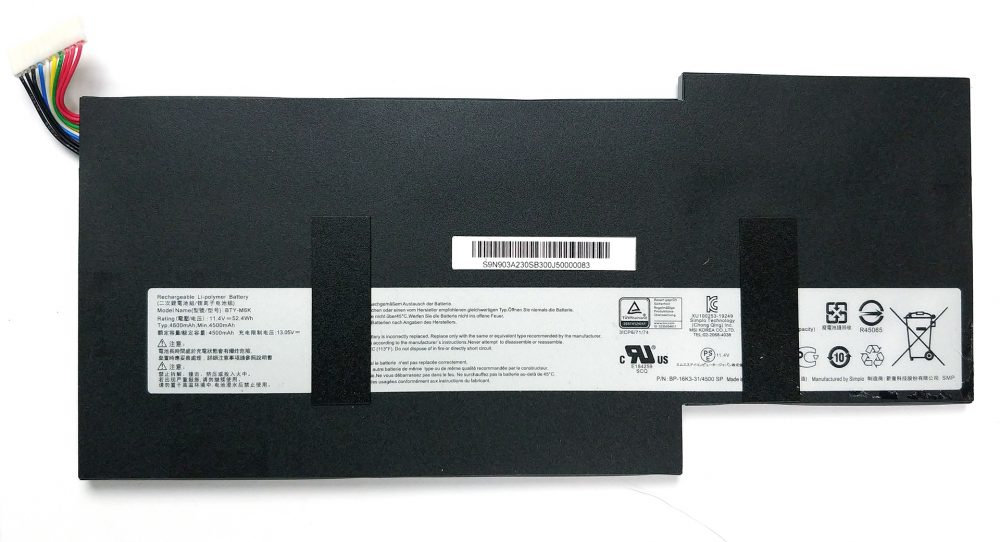
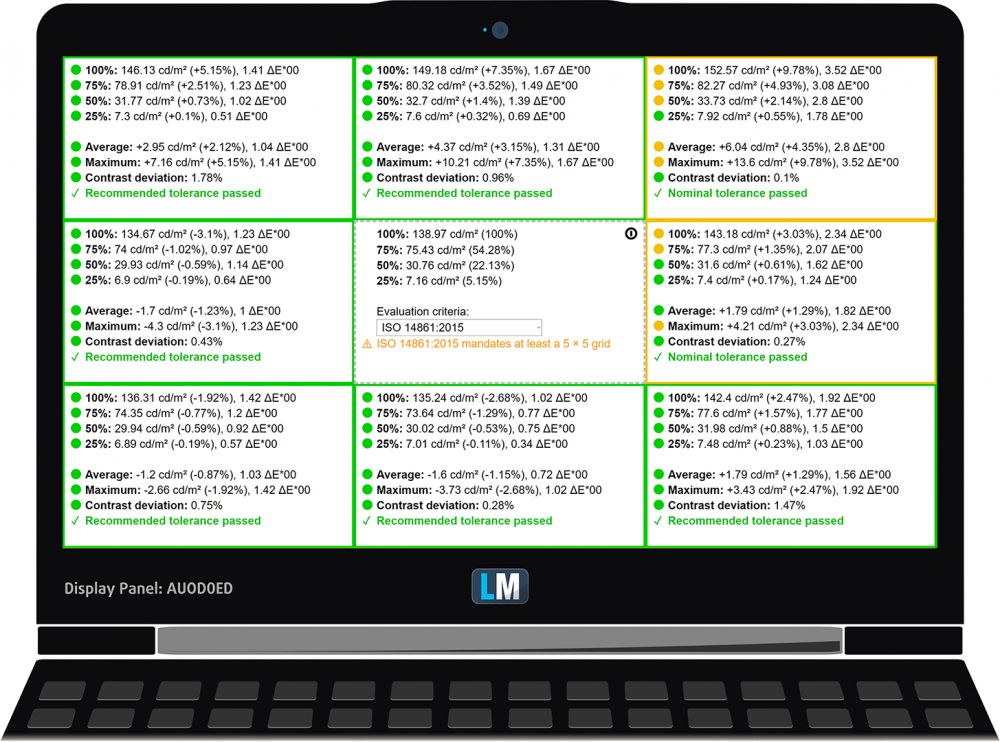

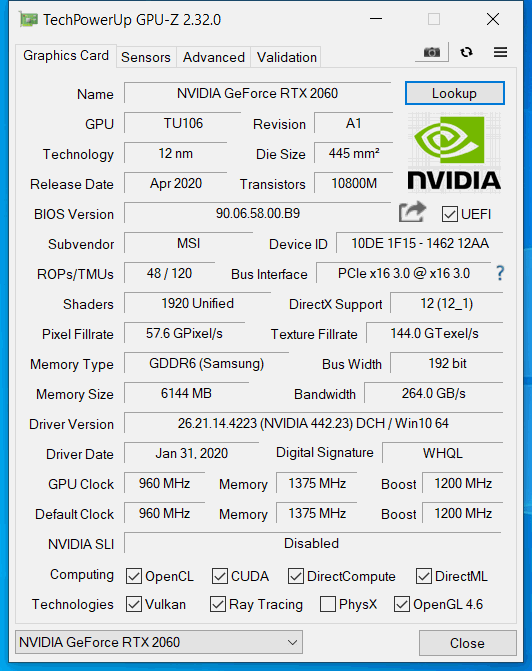








I’ve purchased MSI GF65 aside to having GE75. However, I’ve been totally shocked with the performance and cooling system! I thought there would be such a huge gap but actually, both works perfectly aside to each other (in 3D modeling and rendering). frame rate is excellent, best laptop for that price for either gaming experience or designing and 3d Visualisation. Price is a bonus. Weakness? design needs some improvements regarding texture and material. Also, installed Drivers conflict with each other.. just update all and it will work perfectly.
Overall rating 5/5